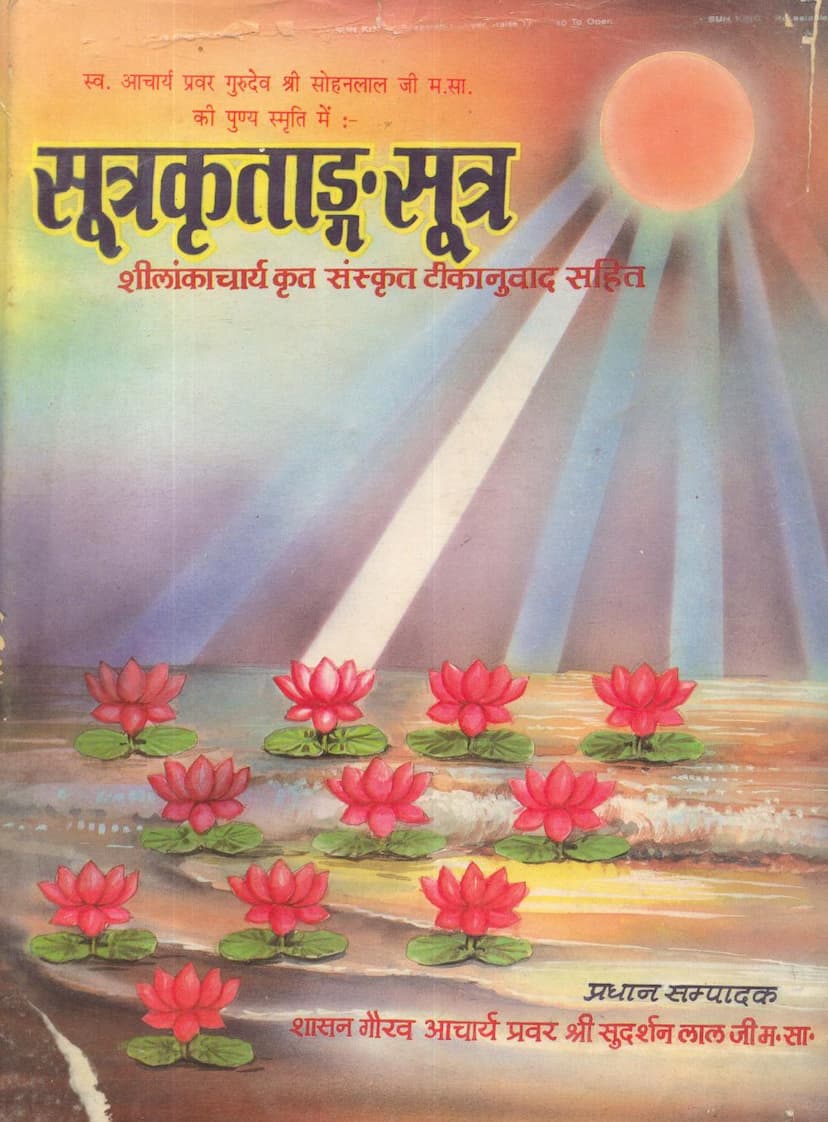Sutrakritang Sutra
Added to library: September 2, 2025

Summary
This document is an excerpt from the Sutrakritanga Sutra, a significant Jain text. It appears to be a Hindi translation with Sanskrit commentary, published by the Shwetambar Sthanakvasi Jain Swadhyayi Sangh. The specific focus is on the Sutrakritanga Sutra, with a commentary by Shilankacharya. The translation and editing were handled by Priyadarshan Muni Ji and Dr. Chhaganlal Ji Shastri, under the chief editorship of Acharya Pravar Shri Sudarshanlal Ji M. Sa.
The document itself is extensive, covering the introductory pages, acknowledgments, foreword, editorial remarks, and the beginning of the first chapter ("Sva Samaya Vaktavyata Adhikara") of the Sutrakritanga Sutra.
Here's a breakdown of the key themes and content presented in the excerpt:
1. Introduction and Dedication:
- The book is dedicated to the memory of Late Acharya Pravar Gurudev Shri Sohanlal Ji M. Sa.
- The preface and editorial remarks highlight the importance of Jain Agamas as ancient scriptures containing the developmental journey of human consciousness towards higher spiritual states.
- It emphasizes the significance of the Sutrakritanga Sutra, particularly its philosophical analysis and the commentary by Acharya Shilanka.
- A strong emphasis is placed on the project's aim to translate these vital Sanskrit commentaries into Hindi for wider accessibility to the general public, filling a gap identified by scholarly monks.
2. Authorship and Editorial Team:
- Chief Editor: Acharya Pravar Shri Sudarshanlal Ji M. Sa.
- Commentary Translator and Editor: Shraddhey Shri Priyadarshan Muni Ji M. Sa. and Dr. Chhaganlal Ji Shastri.
- The publication is by Shri Shwetambar Sthanakvasi Jain Swadhyayi Sangh, and is supported by various Jain organizations and individuals.
3. Content of the Sutrakritanga Sutra (First Chapter Excerpt): The excerpt delves into the philosophical and ethical aspects of Jainism, particularly focusing on:
- Understanding Bondage (Bandhan): The text begins by explaining the concept of bondage (karma and its causes like attachment, aversion, etc.) and the need to understand it.
- Rejection of Materialism and Attachment (Parigraha): It strongly condemns attachment to worldly possessions, wealth, and even simple things like grass or leaves, highlighting that such attachments are the root of suffering and prevent liberation.
- Critique of Other Philosophical Schools: A significant portion of the excerpt (especially the detailed commentary) discusses and refutes various non-Jain philosophical viewpoints prevalent at the time, such as:
-
Chakravarty (Materialistic/Carvaka) views: Denying the soul, afterlife, karma, and emphasizing sensory pleasures.
-
Buddhism: Concepts like momentary existence of phenomena.
-
Samkhya: The role of Prakriti and Purusha.
-
Brahma-centric Creation: The belief in Brahma as the creator.
-
Akarma-vad (Actionlessness): The idea that actions don't lead to karma.
-
Niyati-vad (Fatalism): The belief that everything is predetermined by fate.
-
The concept of a creator deity (Ishvara): Criticized from various logical standpoints.
-
The Five Elements (Panchamahabhuta): Discussed as the sole reality by some.
-
The doctrine of no-soul (Anatma-vad) and momentary existence (Kshanika-vad): Critiqued by the Jain perspective.
-
- Jain Principles: The text implicitly and explicitly promotes core Jain principles:
- Ahimsa (Non-violence): Central to the teachings, extending to all living beings.
- Renunciation (Tyaga): Essential for spiritual liberation.
- Self-control (Samyama): The path to overcoming passions and karma.
- Right Knowledge, Right Faith, Right Conduct (Samyak Darshan, Gyan, Charitra): The Three Jewels of Jainism.
- The nature of the soul (Atma): Discussed in contrast to other philosophical views.
- Karma: The continuous cycle of action and reaction and its consequences.
- The Importance of Equanimity (Samata): The text stresses the need for equanimity, especially in the face of difficult circumstances, internal (passions) and external (ascetic practices), and external attacks.
- The Nature of Suffering (Duhkha): It details how actions, attachments, and ignorance lead to suffering, and the path to its cessation.
- The Purpose of Jain Asceticism: The text describes the rigorous practices of Jain monks, emphasizing detachment, self-control, and the pursuit of liberation.
4. The Role of Commentaries: The publication of the Sanskrit commentary by Shilankacharya along with the Hindi translation is highlighted as crucial for understanding the profound philosophical and ethical concepts within the Sutrakritanga Sutra.
In essence, this excerpt from the Sutrakritanga Sutra, through its translation and commentary, provides a foundational understanding of Jain philosophy, ethics, and the path to spiritual liberation, critically examining and refuting other contemporary belief systems to establish the uniqueness and validity of the Jain doctrine. The detailed philosophical discussions and the meticulous translation project underscore the commitment to preserving and propagating these ancient teachings.